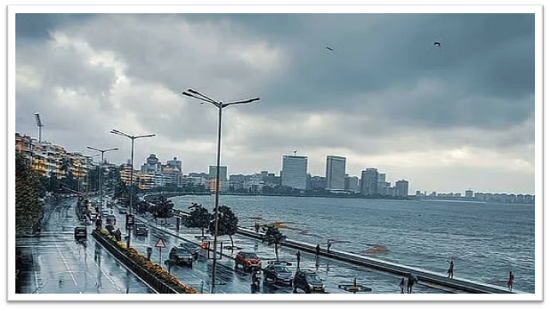
Arabian Sea Depression to Bring Thunderstorms and Showers Across Maharashtra: IMD Issues Yellow Alert for Mumbai
Maharashtra is set to experience an unseasonal wet spell as a depression over the east-central Arabian Sea intensifies, influencing weather conditions across the state. According to the India Meteorological Department (IMD), the system is expected to bring moderate to heavy rainfall, thunderstorms, and gusty winds across Konkan and central Maharashtra until October 30. Mumbai, meanwhile, will see moderate showers early in the week, followed by light rainfall through midweek.
This weather development comes just weeks after the southwest monsoon withdrew from the city on October 10 — its earliest retreat since 2018. Despite the early withdrawal, atmospheric conditions remain conducive for rainfall, driven by the newly formed depression over the Arabian Sea.
Weather System and Current Movement
As of Sunday morning, IMD data indicated that the depression was located near latitude 16.0°N and longitude 66.5°E — approximately 760 km west-southwest of Mumbai and 790 km west of Panjim. The system has been moving south-westward at around 13 kmph over the past six hours. Forecasters expect it to continue in the same direction before gradually shifting toward the south-southwest over the next 24 hours.
Under its influence, Konkan and Madhya Maharashtra will witness fairly widespread moderate rainfall with isolated heavy spells through October 30. Marathwada, too, is likely to receive light to moderate rainfall accompanied by thunderstorms until October 29.
While this weather event may appear unusual for late October, meteorologists have clarified that such post-monsoon depressions are not unprecedented. “The rainfall expected this week does not have a connection with the southwest monsoon,” a senior IMD official explained. “It is due to a depression over the east central Arabian Sea that has been moving south-westward. These systems are normal for this period, given the current atmospheric circumstances.”
Rainfall Forecast for Mumbai and Coastal Districts
Mumbai has been placed under a yellow alert until Monday, signaling moderate rainfall with gusty winds and thunderstorms. The city is likely to experience moderate showers on Monday, followed by light rainfall on Tuesday and Wednesday. For the rest of the week, a green alert will remain in place, suggesting minimal disruption but continued cloud cover.
Districts such as Raigad and Ratnagiri are expected to receive heavier rainfall during this period. The Konkan belt, which includes several coastal towns, may experience localized heavy downpours. Meanwhile, parts of central Maharashtra could see moderate rainfall accompanied by lightning and occasional thunder.
IMD has also forecasted surface winds of 40–50 kmph, which may reach up to 55 kmph in gusts along the Maharashtra-Goa coast. These strong winds, combined with rough sea conditions, have prompted authorities to issue advisories for fishermen.
Fishermen and Coastal Advisory
Fishermen have been strongly advised against venturing into the sea until at least October 30 due to squally weather conditions. IMD has warned of wind speeds reaching 45–55 kmph, gusting up to 65 kmph, around the system’s center over the east-central and adjoining southeast Arabian Sea until October 27.
Sea conditions are expected to remain rough to very rough across the eastern Arabian Sea, while moderate to rough seas are likely along the Maharashtra-Goa and Gujarat coasts on October 26 and 27.
Local Cautionary Signal III (LC-III) has been hoisted at all ports from Dahanu to Shrivardhan on the north Maharashtra coast and from Bankot to Mormugao on the south Maharashtra-Goa coast. Port authorities have been instructed to stay on alert and ensure safety protocols are in place for vessels anchored near the shore.
Impact and Safety Measures
IMD has warned of potential localized impacts, including lightning strikes, fallen trees, and temporary power outages. Low-lying areas in Konkan and coastal regions may experience minor flooding due to heavy rain spells. Agricultural experts have also cautioned that unseasonal showers could affect standing crops, particularly late-harvest varieties in central Maharashtra.
Residents are advised to remain indoors during thunderstorms, unplug electrical appliances, and avoid open areas or water bodies. Authorities have asked district administrations to remain vigilant, particularly in coastal and low-lying zones.
Despite these temporary disruptions, weather experts view this system as part of the seasonal transition period rather than an anomaly. The Arabian Sea often witnesses such depressions post-monsoon as sea surface temperatures remain warm, creating favourable conditions for cyclonic activity.
Understanding the Meteorological Context
Interestingly, this year’s monsoon pattern for Mumbai has been atypical. The city recorded the earliest onset of the southwest monsoon in 75 years — on May 26, 2025 — and one of its earliest withdrawals on October 10. Typically, the withdrawal happens in mid-October, but IMD had earlier predicted a delay due to western disturbances.
These fluctuations highlight the growing influence of regional climate variations and shifting oceanic conditions. While such deviations are not necessarily alarming, they underscore the importance of monitoring weather systems closely as patterns become increasingly unpredictable.
The IMD continues to enhance its forecasting accuracy using satellite imagery, Doppler radar systems, and real-time oceanic data. These tools allow meteorologists to issue timely warnings, helping mitigate risks to life and property.
Preparedness Amid Changing Climate Patterns
The current spell of rain may offer temporary respite from dry post-monsoon conditions, but it also emphasizes the growing need for climate resilience in Maharashtra’s coastal regions. Authorities are increasingly focusing on improving urban drainage, coastal defences, and early warning systems to minimize disruptions during such unseasonal events.
For Mumbai and the Konkan region, these developments reaffirm the city’s delicate balance between weather unpredictability and preparedness. As climate dynamics evolve, so must the city’s infrastructure and response mechanisms — ensuring safety, sustainability, and continuity in one of India’s most weather-sensitive regions.
Weathering the Season Ahead
While the depression over the Arabian Sea is expected to gradually weaken by the end of the week, its short-term impact will be felt across western Maharashtra and coastal districts. For residents, it serves as a timely reminder that nature’s rhythms continue to shape urban life in subtle yet powerful ways.
As Maharashtra braces for a spell of thunderstorms and showers, preparedness and awareness remain the best safeguards. With IMD’s timely advisories and coordinated responses from local authorities, the state is well-positioned to navigate the week’s weather fluctuations safely and efficiently.





